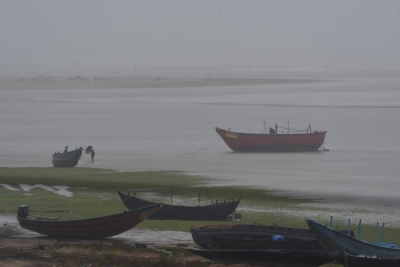Bhubaneswar: Eastern state Odisha has a coastline of 480 km spread over six districts– Balasore, Bhadrak, Ganjam, Jagatsinghpur, Kendrapara, and Puri. The coastal ecosystems are now highly disturbed and very much threatened, due to sea erosion and coastal degradation in some parts of the state.
As per the Odisha Climate Change Action Plan (2021-2030), the coast of Odisha is largely accreting (52.7 per cent) while erosion accounts for 36.9 per cent of the coast. About 10.4 per cent of the coast is stable.
District-wise statistics indicate that erosion is dominant in the district of Kendrapara while accretion is dominant in districts like Bhadrak. The stretch of Paradip to Dhamra – is highly eroding making the region highly prone to hazard.
In addition to this, the region near Rushikulya River is also prone to erosion. Also, as mentioned, in Kendrapra, the region from Mahanadi River to Gahirmatha also witnesses a high erosion rate. The north of Paradip Port and near Hukitola bay accretion is predominantly high, making the region hazard prone.
Similarly, out of the entire coastal stretch of Odisha, around 30 per cent of the area has a less than 5 meter elevation profile which is resulting in about 18 per cent of the coastal zone in the area highly prone to sea water inundation.
It can be observed that Bhadrak and Kendrapara are having comparatively more area which is prone to inundation due to the frequent occurrence of high tides and low elevation profile.
Puri and Ganjam districts comparatively show a high elevation profile resulting in a region less prone to seawater inundation hazards.
The northern region of Balasore has rural settlements situated near the coast and as rural areas dominantly have temporary unstable structures, this area is highly vulnerable to hazards. In addition to this, a huge portion of Bhadrak and Balasore lie under agriculture and aquaculture making the coast vulnerable to hazards in terms of loss of property.
Due to the availability of mangroves, a strong prevalence of aquaculture can be seen in the areas of Kendrapara and Jagatsinghpur making the area near coast more vulnerable to hazards.
In addition to this, due to Balukhand Wildlife Sanctuary and Chilika Lake, about 35 per cent of the region is non-vulnerable. Altogether, 73 per cent of the area lies in medium and high vulnerability zones.
Out of the six coastal districts, Balasore has the highest number of villages that fall in the high population vulnerability zone, followed by Kendrapara and Puri. More than 20 per cent of the villages in Balasore district are vulnerable due to their high population concentration.
Kendrapara district is the worst sea erosion district of Odisha as 16 villages of the district had already been submerged in sea water and 247 people faced displacement due to the rise in sea-level.
Similarly, two villages of Ganjam district have also been affected due to the rise in sea-level. Some villagers of erosion-hit Podampetta and Ramayapatna village of the district had already been displaced.
During the ongoing budget session, in a written statement to Parliament, Union Minister for Science & Technology and Earth Sciences, Jitendra Singh said the turtle nesting site was shifted from Bhitarkanika to Gahirmatha in Kendrapara district due to coastal degradation and erosion.
Loss of habitats, vegetation and sand dunes in Pentha and Satabhaya coast were also reported in Odisha, he said.
There is loss of Casuarina vegetation in Siali and adjoining areas of Jagatsinghpur district and degradation of fishing hamlets in Ramachandi and tourist beach in Puri town.
Besides, fishing hamlets in Podampeta, Ramayapatnam and Gopalpur of Ganjam district were damaged due to the coastal erosion in the state, Singh mentioned in his statement.
The Ministry of Earth Sciences through National Centre for Coastal Research and National Institute of Ocean Technology provides technical solutions to the government of Odisha in mitigation of coastal erosion and they are being implemented by the government of Odisha with their own funds, he added.
Besides, under 15th Finance Commission, the recovery and reconstruction window of National Disaster Response Fund (NDRF) for Rs 1000 crore is earmarked for resettlement of displaced people affected by erosion. In addition, Rs 1500 crore is earmarked for mitigation measures to prevent river and coastal erosion.
The Odisha government has been implementing the Climate Change Action Plan through 11 departments.
The state has taken up the creation of new forests using scientific methods, tried to reduce the usage of water in agriculture and brought changes in building construction codes, official sources said.
IANS
